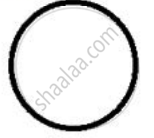Advertisements
Advertisements
Question
A body is moving along a circular path of radius r. What will be the distance and displacement of the body when it completes:
Full revolution
Solution

Distance travelled is =perimeter of circle.
So distance travelled is =2π r.
Displacement =0 as starting and ending point are coinciding.
APPEARS IN
RELATED QUESTIONS
What is the difference between distance travelled by a body and its displacement ? Explain with the
help of a diagram.
If the displacement of an object is proportional to the square of time, then the object is moving with :
A bird sitting on a wire, flies, circles around and comes back to its perch. Explain the total distance it traversed during its flight and its eventual displacement.
Define Distance.
From the displacement – time graph shown given below calculate:
- Average velocity in the first three seconds.
- Displacement from the initial position at the end of 13 s.
- Time after which the body is at the initial position,
- Average velocity after 8 s.

A motorbike running at 90 kmh−1, is slowed down to 54 kmh−1 by the application of brakes, over a distance of 40 m. If the brakes are applied with the same force, calculate
- total time in which bike comes to rest
- total distance travelled by bike.
A particle is moving in a circular path of radius r. The displacement after half a circle would be
The shortest distance between two places is ______.
State whether true or false. If false, correct the statement.
Distance covered by a particle never becomes zero but displacement becomes zero.
A body is projected up with an initial velocity of u m/s. It goes up to a height, ‘h’ meters in seconds' time. Then it comes back at the point of projection.
Considering negligible air resistance, which of the following statement is true?
